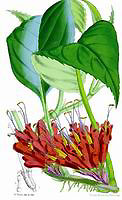
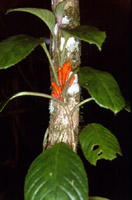
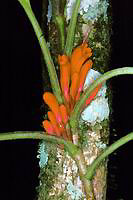
Left: Bot. Mag. t. 5747 (1868), as Agalmyla
staminea
Middle & right: Java, Cibodas, phot. A. Weber (1995)
Full name and orig. publication: Agalmyla Blume, Bijdr. Fl. Ned. Ind. 766 (July - Dec. 1826).
Etymology: From the Greek αγαλμα, agalma, ornament; and ΰλη, hule [hyle], wood, forest; “ornament of the forest” because of the brilliant red flowers.
Synonyms: Orithalia Blume (1828), nom. illeg., Orythia Endl. (1841), sphalm. for Orithalia; Dichrotrichum [Reinw. ex], De Vriese (1856), (1919), Tetradema Schltr. (1920).
Infrafamilial position: Didymocarpoid Gesneriaceae - "Advanced Asiatic and Malesian genera" (Weber 2004).
Description: Perennial climbers with short roots produced along the stem, a few spp. terrestrial shrubs. Leaves opposite, of herbaceous texture, usually strongly anisophyllous (isophyllous in the terrestrial species), large leaf variable in shape and indumentum, small leaf scale-like and caducous or with short petiole and blade. Cymes axillary, subsessile to long-pedunculate; bracteoles variable in size and conspicuousness; flowers much congested. Sepals usually connate, rarely free. Corolla usually with a distinctly arcuate tube; limb weakly to strongly bilabiate, the upper lip of 2 lobes and the laterals spreading, or the two upper and two lateral lobes forming the upper lip; mouth open or laterally compressed; colour red, with or without black lines on the lobes, sometimes yellow in the throat; inside of the tube towards the base with (or without) an annulus or with five patches of hairs. Fertile stamens 4, didynamous, in a few species only 2, exserted; filaments inserted at middle of corolla tube, anthers synthecous, if four then those of the shorter stamens sometimes smaller, coherent in pairs by their apices, thecae parallel, dehiscing longicidally. Nectary annular to cupular. Ovary slender-cylindrical, often stipitate; stigma bilobed, with two large lateral lobes. Capsule elongate, cylindric, dehiscent by two and then four valves. Seeds with a filiform appendage at each end, the apical one brown, the hilar one hyaline; seed attached at the base of, or near the top of the hyaline appendage.
Chromosome number: 2n = 32.
Species number: 96 (Hilliard & Burtt 2002).
Species names (incl. publication and synonyms): See Skog, L.E. & J.K. Boggan. 2005: World checklist of Gesneriaceae: http://persoon.si.edu/Gesneriaceae/Checklist.
Type species: Agalmyla parasitica (Lam.) Kuntze
Distribution: Malesia (Sumatra, Malay Peninsula, Borneo, Java, Sulawesi, New Guinea).
Ecology: Occurring in lowland and montane rainforest, mostly climbers.
Notes: Hilliard & Burtt (2002) subdivide the genus into three sections:
(1) sect. Agalmyla (strongly anisophyllous, minor leaf scale-like, inflorescence sessile or subsessile, annulus or patches of hairs in corolla tube present, stamens 4 or 2, long exserted; Malay Penins., Sumatra, Java, Borneo, Palawan),
(2) sect. Exannularia Hilliard & Burtt (anisophyllous, minor leaf with petiole and blade, corolla without annulus; Sulawesi and nearby islands),
(3) sect. Dichrotrichum (De Vriese) Hilliard & Burtt (habit as in sect. Exannularia, infl. mostly pedunculate, stamens always 4, not or scarcely exserted, corolla with annulus or five patches of hairs; Philippines, Moluccas, New Guinea).
Thus the first section occurs only west, and the two other ones only east of Wallaces’s line. Agalmyla seems remotely allied (and not as close as suggested by the similar corolla shape and colour) to Aeschynanthus, but differs essentially in most species (a) in the climbing (vs. epiphytic) habit, with the stem rooting in the soil and clinged to bark of the host tree by numerous short roots, and (b) in the strongly anisophyllous leaves. Size, shape and coloration of the flowers indicate pollination by birds.
Selected references: Ridley, Fl. Malay Penins. 2: 501 (1923), reg. rev.; Backer & Bakh. f., Fl. Java 2: 525 (1965), reg. rev.; Burtt, Notes Roy. Bot. Gard. Edinburgh 28: 219-225 (1968), notes; Rosser & Burtt, Notes Roy. Bot. Gard. Edinburgh 29: 39-58 (1969), anat.; Burtt, Edinburgh J. Bot. 49: 285-296 (1993), new spp.; Hilliard & Burtt, Blumea 44: 381-389 (1999), new spp.; Hilliard & Burtt, Edinburgh J. Bot. 59: 1-210 (2002), rev.
Bibliography: See Skog, L.E. & J.K. Boggan. 2005. Bibliography of the Gesneriaceae. 2nd edition: http://persoon.si.edu/Gesneriaceae/Bibliography.
Illustrations:

|

|

|
Agalmyla parasitica
(Lam.) Kuntze, type species
Left: Bot. Mag. t. 5747 (1868), as Agalmyla
staminea
|
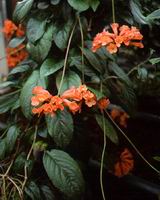
|
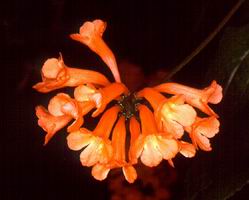
|
Agalmyla chorisepala (C.B.Clarke) O.M.Hilliard & B.L.Burtt
Cult. RBG Edinburgh, phot. A. Weber (2002) |
last modified: 2007-07-13